One of J.M.W.Turner's greatest watercolours left in private hands sells for £2 million
Lot 209. Joseph Mallord William Turner, R.A., The Lake of Lucerne from Brunnen, Watercolour over traces of pencil, heightened with bodycolour, scratching out and stopping out, 308 by 469mm. Estimate £1,200,000-1,800,000. Lot sold £2,050,000. Courtesy Sotheby's.
LONDON.- Today at Sotheby’s, a stunning Swiss landscape by Britain’s favourite artist, J.M.W. Turner sold for £2 million, among the top prices ever achieved for a watercolour by the artist.
Created in the final years of the artist’s life and widely considered to be the pinnacle of his achievements in the medium, The Lake of Lucerne from Brunnen depicts one of the most dramatic landscapes in the Swiss Alps, capturing the view over the picturesque village of Brunnen on the eastern shores of Lake Lucerne. Inspired by Turner’s travels to the region between 1841 and 1844, the work was commissioned by Turner’s great patron Elhanan Bicknell to hang as a companion piece to the iconic Blue Rigi, which achieved a record price at Sotheby’s in 2006 and now hangs in Tate Britain . Works from Turner’s ‘late’ Swiss series, of which this is one, have come to be seen as the ‘climax of a lifetime devoted to the expression of light and colour’.
Mark Griffith-Jones, Specialist, British Watercolours, Drawings and Portrait Miniatures at Sotheby’s said, ‘It has been such a privilege to get to know this superb work – whose beauty and history are so captivating. Major watercolours from Turner’s late Swiss period are justifiably held in the highest regard and this was the most important work to have appeared on the market in more than a decade. We were thrilled to see it generate such excitement among private collectors and institutions alike.”
The Lake Of Lucerne From Brunnen sold alongside seven other works by Turner, bringing the combined total of works by the British artist sold in the sale to £3,045,750. Among the other Turner watercolours that fetched strong prices was a view of St. Mawes, Cornwall, and one the artist’s most important watercolours of the Isle of Wight. A further work by Turner – one of only two oil paintings of London remaining in private hands – will be offered at Sotheby’s later this evening.
Lot 206. Joseph Mallord William Turner, St. Mawes, Cornwall. Watercolour over traces of pencil, heightened with stopping out, scratching out and gum arabic, 291 by 420 mm. Estimate £150,000 — 200,000. Lot sold £430,000 . Courtesy Sotheby's
Lot 201. Joseph Mallord William Turner, West Cowes, Isle of Wight. Watercolour over traces of pencil, heightened with bodycolour, scratching out and stopping out, 291 by 425 mm. Estimate £200,000–300,000. Lot sold £322,000. Courtesy Sotheby's.
Lot 21. Joseph Mallord William Turner, Walton Bridges,signed lower right: J M W Turner R A, oil on canvas, 92.7 x 123.8 cm.; 36 1/2 x 48 3/4 in.. Estimate £3,000,000 — 5,000,000. Lot sold £3,370,000 . Courtesy Sotheby's.
A further highlight of this morning’s sale was the preparatory study by Pierre Prévost for an extraordinary lost panorama of London which sold for £250,000. Measuring over 6-metres in length, this extraordinary vista of London which offers a unique view of the city in the early-19th century, was unknown until very recently. Highly finished with incredible detail and topographical accuracy, the drawing depicts an easily recognisable vista of London as seen from the tower of St. Margaret’s Church, Westminster.
Lot 79. Pierre Prévost (Montigny-Le Ganelon 1764 - 1823 Paris), A Panoramic View Of London, From The Tower Of St. Margaret's Church, Westminster. Watercolour and bodycolour over pencil, squared for transfer in pencil, the squares numbered, on multiple sheets of paper laid onto canvas, 850 by 6050 mm. Estimate £200,000–300,000. Lot sold £250,000.Courtesy Sotheby's.
This recently rediscovered panoramic view of London is over six metres wide, but is still only one fifth of the size of the finished painting, for which it is the study. That painting – now lost – dates from was just after the end of the Napoleonic Wars. It was installed from 1816 until 1819 in a purpose-built, circular structure, erected in central Paris, which visitors paid handsomely to enter, immersing themselves in the illusionistic sensation provided by this highly detailed, carefully lit, circular image, which instantly transported them into the heart of London.
Towards Kensington, Chelsea and Hyde Park. From Pierre Prévost, A Panoramic View Of London, from the Tower of St. Margaret's Church, Westminster. Courtesy Sotheby's.
The leftmost part of Prévost’s panoramic vista shows the view to the west. From his elevated position on the tower of St. Margaret’s Church, we see Chelsea in the distance, with Hyde Park further to the right. In the foreground are various shops on Princes Street, several of which (including a solicitors and a supplier of children’s goods) can be identified, thanks to surviving street directories of the period. There was even light industry: one large building is prominently signed ‘Emery Glass Paper Manufacturers.'
Further back is the building that would later become Buckingham Palace. Originally built in 1703 as the townhouse of the Duke of Buckingham, it was adopted during the reign of King George III as a private retreat for Queen Charlotte, and renamed ‘The Queen’s House’. In 1826, only a few years after Prévost completed this panorama, King George IV employed the architect John Nash to expand the house into a palace, and since Queen Victoria came to the throne in 1837, Buckingham Palace has been the official London residence of the monarch.
The Middlesex Guildhall and St. James’s. From Pierre Prévost, A Panoramic View Of London, from the Tower of St. Margaret's Church, Westminster. Courtesy Sotheby's.
The foreground of this detail of the panorama is occupied by the Middlesex Guildhall, the site of which was used as a market from 1750 to 1800, before being adopted by the Justices of the City and Liberty of Westminster for their new guildhall. The building, with its distinctive octagonal plan and Doric portico, was designed by Samuel Pepys Cockerell (1753-1827), a notable architect of his day but perhaps better known as the father of Charles Robert Cockerell (1788-1863). It was replaced at the end of the 19th century by the building that stands on the site today.
Behind the Guildhall, roads and houses lead to St. James’s Park, towards the right. The park became royal land in 1532, when it was purchased by King Henry VIII to accompany York Palace (later Whitehall). King James I landscaped the area and it became home to a variety of exotic animals, including camels and an elephant. From the late 17th century to the early 19th century, when Prévost gazed over the park, cows were grazed there, and fresh milk could even be bought in St. James’s Park at this time.
Whitehall, Horseguards and St. Martin-in-the-Fields. From Pierre Prévost, A Panoramic View Of London, from the Tower of St. Margaret's Church, Westminster. Courtesy Sotheby's.
Occupying this central area of the panorama is a view up Whitehall towards modern day Trafalgar Square. The road leads up towards the great James Gibbs church of St. Martin-in-the-Fields (1722-26), passing Old Horse Guards to the left, and the Banqueting House – the last surviving part of the Tudor Palace of Whitehall – on the right. Completed for King Charles I, at great expense, in 1622, the Banqueting House was designed by Inigo Jones in a classicising style greatly influenced by that of Andrea Palladio, and is the earliest such neoclassical building in England.
Towards the end of Parliament Street, which turns into Whitehall, is what would now be Trafalgar Square, which began to be cleared and developed in 1826, while further to the left, on the far side of St. James’s Park, we see Carlton House, famously refurbished at immense expense for the Prince Regent (later King George IV) between 1783 and 1796, and demolished in 1826. On the horizon to the right is what appears to be the Foundling Hospital, the orphanage founded in 1739 by the philanthropic Thomas Coram.
The River Thames, towards Waterloo Bridge. From Pierre Prévost, A Panoramic View Of London, from the Tower of St. Margaret's Church, Westminster. Courtesy Sotheby's.
Down the river from Westminster Bridge lies what is now known as Waterloo Bridge. The first bridge on this site, initially named the Strand Bridge, was designed in 1809-10 by John Rennie (1761-1821), and opened in 1817 as a toll bridge. Prévost accurately depicts the bridge, with its nine distinctive arches, while still under construction: at its north end (to the left, as seen here), the final arch and the connecting pier leading the carriageway to land remain incomplete.
Just behind this end of the bridge is Somerset House, designed by Sir William Chambers in 1776, and on the same bank of the river but slightly closer to Westminster, the Adelphi Buildings are visible. A group of 24 unified neoclassical terraced houses, the Adelphi Buildings were constructed between 1768 and 1772 to designs by the Adam brothers, and were demolished in the 1930s, to be replaced by an Art Deco building. In the foreground, the company of marching soldiers reminds us both of the ceremonial significance of this part of London, and of the recent Napoleonic wars.
St. Paul’s, the City and Westminster Bridge. From Pierre Prévost, A Panoramic View Of London, from the Tower of St. Margaret's Church, Westminster. Courtesy Sotheby's.
Beyond Waterloo Bridge, the river bends round towards the towering presence of St. Paul’s Cathedral, designed by Christopher Wren to replace the old cathedral, destroyed in 1666 in the Great Fire of London. Building work on the new cathedral began in 1675. Standing at a height of 365ft, St. Paul’s still dominated the London skyline at the time of Prévost’s panorama, and would do so for at least another 150 years. Further to the right, the skyline is filled with the spires of the City of London churches – many of them commissioned, like St. Paul’s, to replace buildings lost in the Great Fire, and designed by Wren, and associates such as Nicholas Hawksmoor.
Modern day South Bank can also be seen in this detail; in the early 19th century the site now occupied by the London Eye was marshland that was only beginning to be urbanised. The Old Vic theatre was established in 1818, and run-down taverns became music halls and ‘Penny gaffs’. In the foreground of this section, on the near side of the river, is New Palace Yard, where the Elizabeth Tower, housing Big Ben, now stands, approximately where Prévost has shown a small tree.
Westminster Hall and the Old Houses of Parliament. From Pierre Prévost, A Panoramic View Of London, from the Tower of St. Margaret's Church, Westminster. Courtesy Sotheby's.
As is evident from this panorama, the Palace of Westminster looked very different in 1815 from how it appears today. The medieval royal palace seen here was largely destroyed by a disastrous fire, originating from two furnaces under the House of Lords, which raged through the night of 16th October 1834, destroying St Stephen’s Chapel (the then meeting place of the House of Commons), the Lord’s Chamber and the Painted Chamber, as well as a number of residential apartments in the palace.
The imposing Westminster Hall, which dominates the centre of this view, was one of the only significant medieval structures to survive. The competition to design the replacement Palace was won by Charles Barry who, working together with Augustus Pugin, created the iconic Gothic Revival edifice that exists today, so often seen as a defining symbol of Britain, and even of democracy itself.
Towards Lambeth and Battersea. From Pierre Prévost, A Panoramic View Of London, from the Tower of St. Margaret's Church, Westminster. Courtesy Sotheby's.
Looking across the river towards the south west, the proximity of London’s rural outskirts is very striking. Trees and greenery run along the bank of the river leading up to Lambeth Palace, though further right, in Battersea, the edge of the river is lined by houses. Various factories and businesses were just beginning to be established in Battersea, but the surrounding fields were still an important source of vegetables, fruits and flowers for London’s markets. Looking further, towards modern day Vauxhall and Nine Elms, we see a windmill, Randall Mill, which was in use from 1762 until 1836.
At this time, a feature of the river banks of Battersea were the potteries that flourished there. Known now as the Early Lambeth potteries, they made a variety of earthenware, including tiles, tableware, wine and medicine jars. In 1570, two Antwerp potters, Jasper Andries and Jacob Janseon, settled in Lambeth, and were the first makers of a tin enamelled earthenware that was later known as Lambeth Delftware. During the second half of the 18th century, though, their businesses came under increasing pressure from the potteries of Staffordshire, whose cream-glazed earthenware was better suited to domestic tastes of the time.
Westminster Abbey. From Pierre Prévost, A Panoramic View Of London, from the Tower of St. Margaret's Church, Westminster.
The proximity to Westminster Abbey of Prévost’s vantage point on the top of the tower of St. Margaret’s allowed him to portray the intricate gothic architecture of the Medieval abbey building in immense detail, and with great sensitivity. We also see here ample proof of Prévost’s extraordinary skill in capturing the effects of the light, as it filters through the flying buttresses of the cathedral.
This section of the panorama also highlights Prévost’s attention to detail: the clock face on the cathedral tower indicates the time is noon, and throughout the panorama we see sun falling in exactly the right direction, and casting its shadows appropriately, even taking into account the complications imposed by the circular form of the final painted canvas.

/https%3A%2F%2Fprofilepics.canalblog.com%2Fprofilepics%2F1%2F0%2F100183.jpg)
/https%3A%2F%2Fstorage.canalblog.com%2F03%2F02%2F119589%2F96711876_o.jpg)
/https%3A%2F%2Fstorage.canalblog.com%2F11%2F31%2F119589%2F94773502_o.jpg)
/https%3A%2F%2Fstorage.canalblog.com%2F20%2F83%2F119589%2F94772815_o.jpg)
/https%3A%2F%2Fstorage.canalblog.com%2F26%2F72%2F119589%2F75604929_o.jpg)
/https%3A%2F%2Fstorage.canalblog.com%2F59%2F60%2F119589%2F26458628_o.jpg)

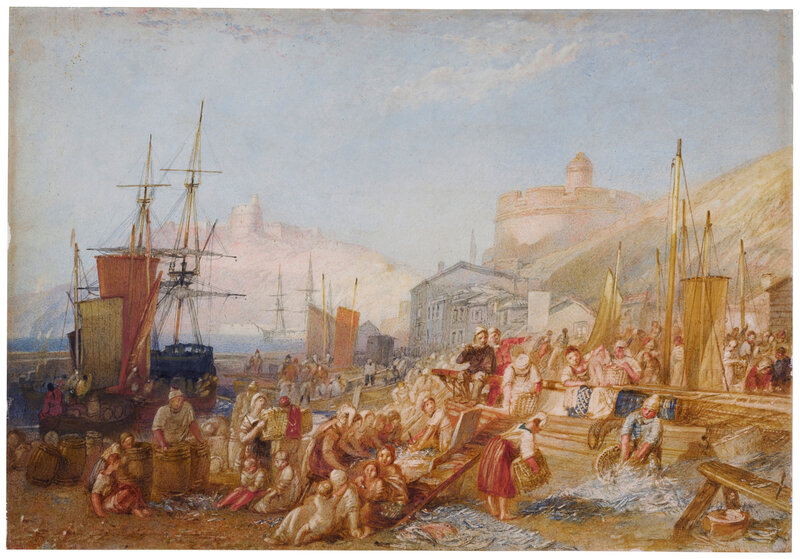
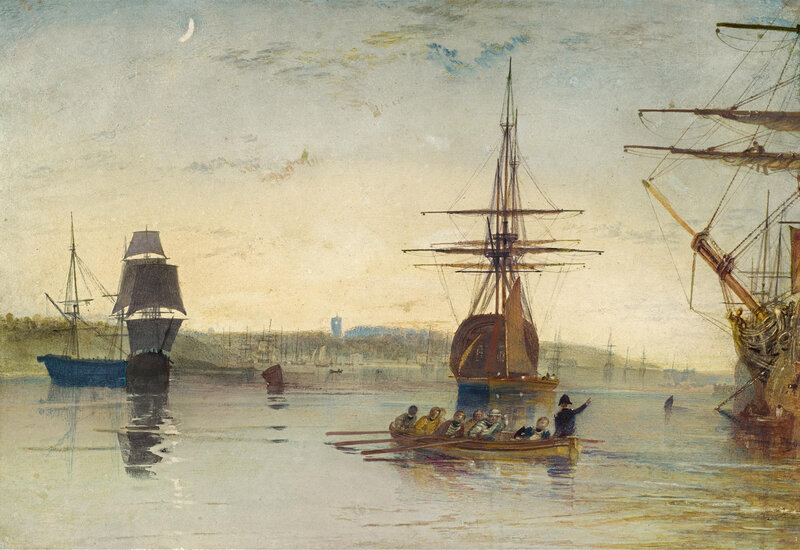


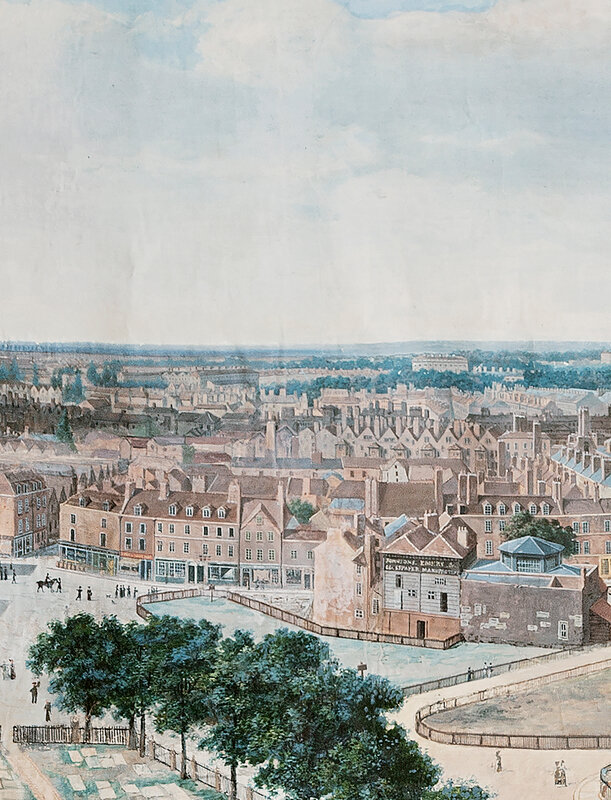

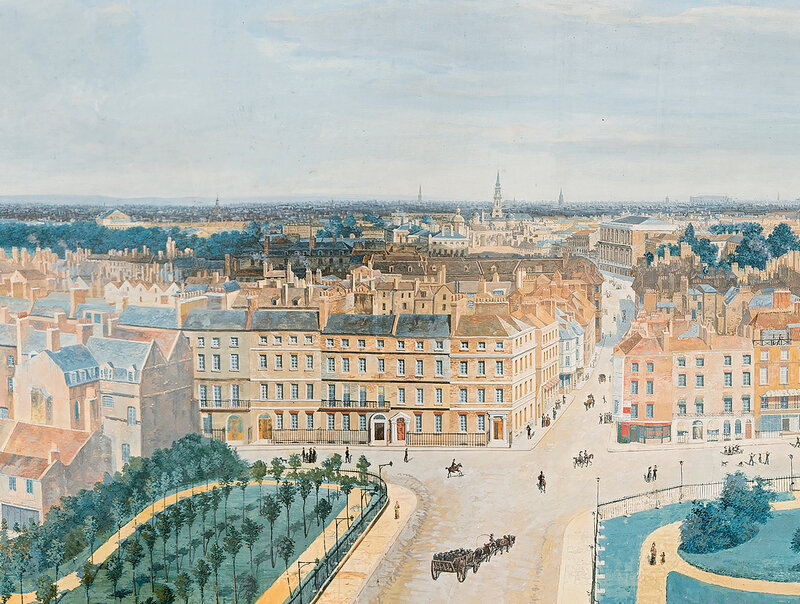
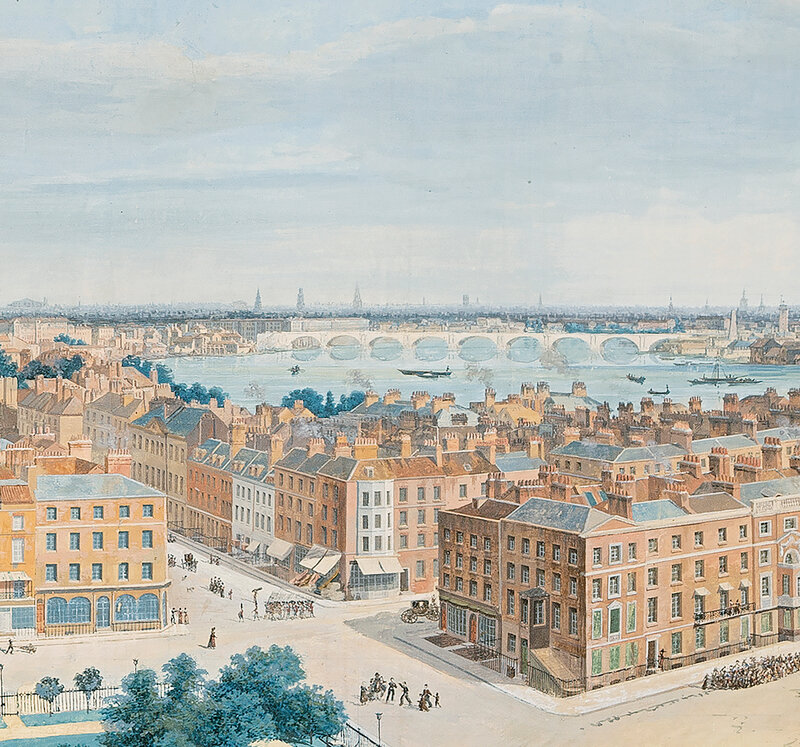

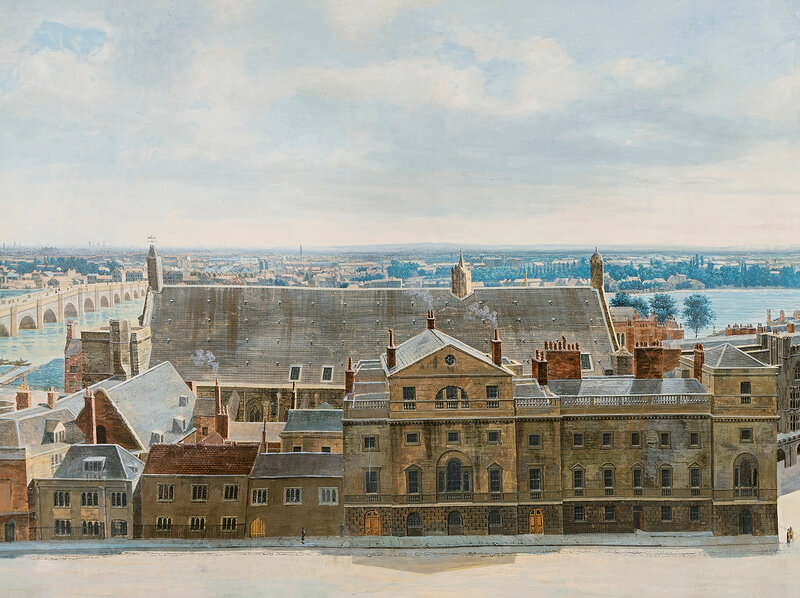
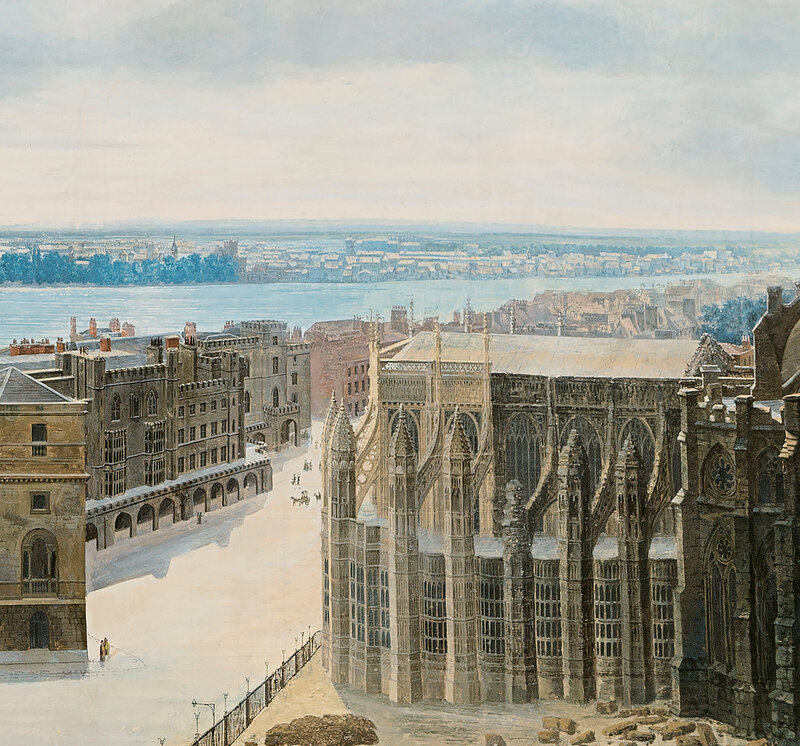
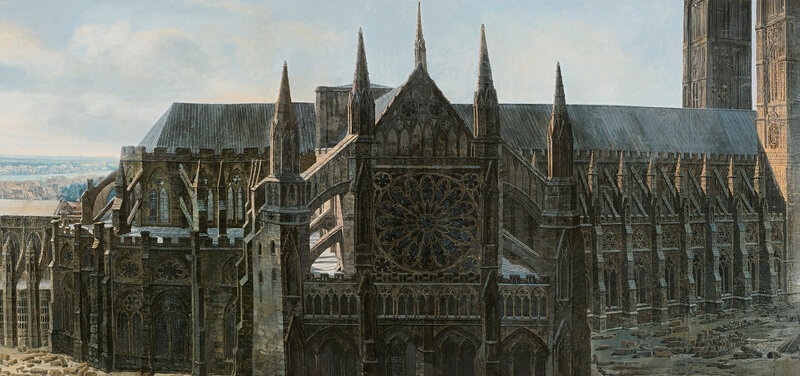


/http%3A%2F%2Fstorage.canalblog.com%2F65%2F91%2F119589%2F128054923_o.jpeg)
/http%3A%2F%2Fstorage.canalblog.com%2F43%2F69%2F119589%2F122293629_o.jpg)
/http%3A%2F%2Fstorage.canalblog.com%2F04%2F35%2F119589%2F110705752_o.jpg)
/http%3A%2F%2Fstorage.canalblog.com%2F28%2F12%2F119589%2F96752355_o.jpg)